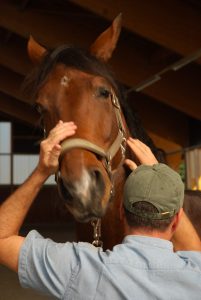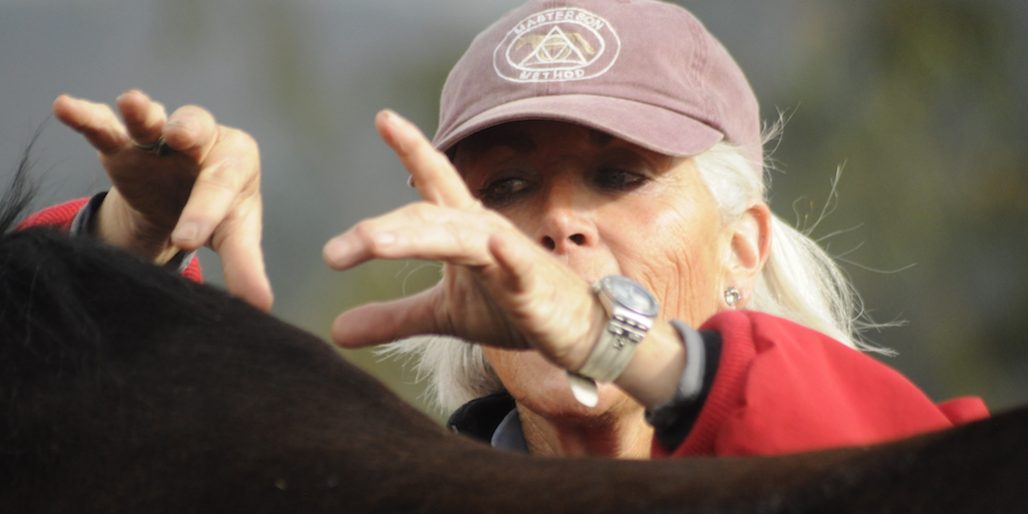by Sandy Vreeburg
We invited Sandy Vreeburg, Instructor Lead & Trainer in North America, to write this month’s blog post, and are excited to share her wisdom!
Soften, yield, and observe the subtlest responses of the horse. These practices are the foundation of The Masterson Method®. There are layers and layers of subtleties built within those three foundational words. Fine-tuning them is imperative to be successful in your Masterson Method learning journey.
The Laws of Softening

If the horse braces, stay with him, with soft hands.
It seems to me that many humans are unconscious in most of their actions throughout the day. The art of being successful with horses – be it as a trainer, rider, groom, volunteer horse handler or someone practicing bodywork – is intertwined with your awareness of your presence, meaning your breath, stance, and thoughts. Your breath should be smooth flowing and unrestricted, your stance should be relaxed (maybe relax a hip of your own as you look for your horse to relax his hip), and your thoughts should be quiet, calm, caring, present, and non-goal (or non-action) oriented.
One of Jim’s sayings is this: “When the horse braces, resists, or evades—soften, then ask again.” This means soften your hands, arms, shoulders, legs, and the rest of your body. Let go of your own tension. If you don’t, and you continue to ask or apply pressure, the horse will continue to brace, resist, or evade. These are among the Laws of Softening that you learn as you progress through coursework
Softening and Observation
Another facet of softening comes from Observation, which influences how I approach the horse and how he responds to me. I like to enter the stall with a very soft eye and maintain that soft eye and quiet mind throughout my time with the horse. Before I enter the stall I stand at the door and speak softly to the horse and wait to see if he acknowledges me, steps towards me or further away, and possibly even faces the corner. After speaking with him and entering quietly with the halter and lead in my hands relaxed by my sides, I again wait to assess his comfort level. As I approach the horse I gently reach out and offer that they sniff my cupped hands. After their muzzle has investigated my hands they often feel “safe enough to be curious” to do a bit more research and then sniff my face. Once their curiosity is satisfied a deep breath ensues and I am ready to proceed, put the halter on, and begin the session. If I become too proactive in regard to wanting to get something done, I guarantee that my session will not be well received. Additionally, if I stare with a hard eye with too much focus on the horse’s body he will brace immediately and try to block me from having any communication with him. Adjusting your touch and movements when you observe the slightest hint that the horse is about to brace or move away from you will serve you well.
I have a few sayings that I use every time I teach and two of them are:
“The softer your eye, the more you see.”
“The softer your touch, the more you feel.”
The Art of Yielding

You can gently ask the horse to yield his hind quarters.
Jim guides us in the Art of Yielding in his bodywork courses. He gives great examples of mindfulness in regard to the pressure we use with our hand on a halter or lead rope or on the horse’s hip when gently asking him to yield his hindquarters and move over. I think that a key concept that helps all of us truly incorporate this practice of yielding is if we take into account that the horse leads from behind.
Lead horses position themselves behind the herd, and they gently push them ahead. When we ask a horse to move during a bodywork session—either to position both the horse and ourselves to a safer place or to guide the horse if he feels the need to move during the session—it is best that we do this with the gesture of leading from behind.
Here’s how this might look: the lead rope is loose enough for the horse to feel the freedom of his head and when the practitioner simply stands at the horse’s hip with the horse’s nose slightly tipped to the inside of the circle, the horse can have the freedom of moving his feet while staying in a nice close position to you. The horse feels safe and believes that you are trustworthy because you are guiding him with calm confidence in the same way that the leader of his or her herd would do.
The Subtleties of Intention
I believe that words paint pictures, and those pictures often ignite energy and actions in our body that are likely unseen to the casual observer, but not to the horse. While helping a student with a technique to release the muscles surrounding the shoulder, the student asked for guidance, and began her question with, “When you take the leg down and forward…?” I immediately rephrased the student’s question and answered saying that, “I never ‘take’ a leg anywhere. I ‘ask’ for the horse’s leg and then I’ll follow it out to where he can set it in a relaxed state.” That subtle rephrasing will very likely embed softness immediately into the student’s technique.
 Another example of how Intention Matters is this. Recently, during an Advanced Course, a student very successfully calmed, and was then able to work beautifully with a young, athletic Warmblood who tends to take time to settle. I asked her how she was able to settle him so easily at the beginning of her session. Her response was, “I told him, ‘I just want to listen and hear what you have to say’.” I used that as a somatic example for the class, and had them compare the feeling in their body that they had when they visualize a caring friend say, “I just want to hear what you have to say,” versus “I just want to help you,” or “I just want to fix you.” Try this yourself now. Can you feel the difference in your breath and in your body, and then in your willingness to reveal your secrets when you compare those phrases? Just as the horse does when he feels safe enough to show us the part of his body that he’s been protecting.
Another example of how Intention Matters is this. Recently, during an Advanced Course, a student very successfully calmed, and was then able to work beautifully with a young, athletic Warmblood who tends to take time to settle. I asked her how she was able to settle him so easily at the beginning of her session. Her response was, “I told him, ‘I just want to listen and hear what you have to say’.” I used that as a somatic example for the class, and had them compare the feeling in their body that they had when they visualize a caring friend say, “I just want to hear what you have to say,” versus “I just want to help you,” or “I just want to fix you.” Try this yourself now. Can you feel the difference in your breath and in your body, and then in your willingness to reveal your secrets when you compare those phrases? Just as the horse does when he feels safe enough to show us the part of his body that he’s been protecting.
Learning the Masterson Method ignited my passion for exploring the intricacies of the equine (and human) body through in-depth research. While I never questioned the efficacy of the work, I wanted to know more. One of my many Aha moments that quadrupled my zeal for the work that we do was when I first heard a licensed naturopath share her belief that, “the body needs to give license to heal.” That’s a perfect match for Jim’s principle in The Masterson Method that “we work with the horse, not to the horse, otherwise it doesn’t work.”
For the horse to give us license and for us to be successful, we need to soften, yield, and observe the subtle responses of the horse, just as Jim has taught us. When we do, the horse will relax and develop trust and connection with us because he knows we are seeing him and responding in a very caring way.
Sandy is an MMCP, Mentor, Coach, and Masterson Method Instructor. While she has always thrived on being productive,The Masterson Method® has taught Sandy to slow down, be in the moment and truly wait to see what the horse has to say. The responses of the horses that Sandy has worked on, and that of their owners, have been delightfully overwhelming. For more about the author, go to Sandy Vreeburg, MMCP.













